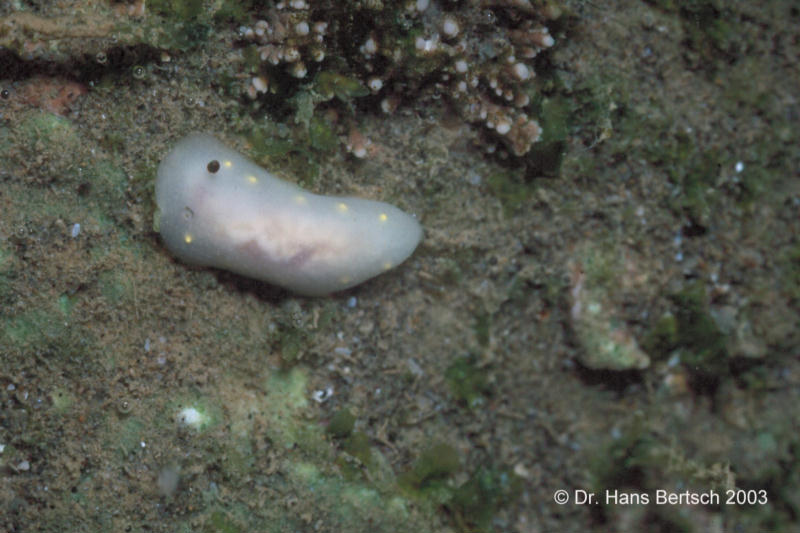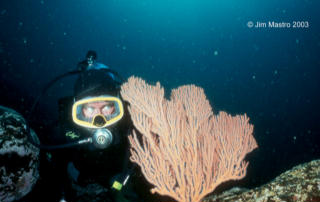 |
Cadlina flavomaculata
Photo courtesy of Dr. Hans Bertsch
Cadlina flavomaculata MacFarland, 1905
With this BOW I continue a series on northeastern Pacific (California and western Mexico coasts) species of Cadlina . This week, I wish to present Cadlina flavomaculata , a relatively rare species that I first saw more than 35 years ago! I first observed Cadlina flavomaculata during my research in San Mateo County, in December 1967 and 1968 (please note, that Table 3, in Bertsch et al., 1972: 310, is regrettably erroneous in its presentation of data for this species; please see the text). The total number of 16 specimens we observed in this San Mateo study during the period of 24 June 1966-18 July 1970, represent 3.35% of the total 478 specimens we recorded.
Since then, I have photographic evidence of my sightings of this species in the San Diego region and the northern and central western coasts of the Baja California peninsula.
------Subtidal:
------------- Flood Control Channel, San Diego, 26 August 1978, 10 feet deep
-------------Off Point Loma, San Diego, 4 February 1979, 75 feet deep
-------------Off Point Loma, San Diego, 10 February 1979, 70 feet deep
------------- Off Point Loma, San Diego, 24 December 1979, 48 feet deep
------------- Off Point Loma, San Diego, 5 January 1980
(illustrated) , 75 feet deep
------------- Off
Point Loma , San Diego, 10 February 1980, 40 feet deep
------------- Off Point Loma, San Diego, 1 June 1980, 55 feet deep
------------- Arbolitos, south of Ensenada, Baja California, México, 35 feet deep
-----Intertidal:
------------- Bahía Tortugas, Baja California Sur, México, intertidal
In Jim Nybakken's ( 1978) excellent pioneering study "Abundance, Diversity and Temporal Variability in a California Intertidal Nudibranch Assemblage," he reported that Cadlina flavomaculata as the eleventh most common species that he encountered. He reported observing 79 specimens of Cadlina flavomaculata out of a total number counted of 4162 specimens. This calculates to 1.9% of the total number observed, far lower than I and my colleagues (Bertsch, et al., 1972) reported.
McDonald (1983) cited the known distribution of Cadlina flavomaculata as from Vancouver Island, British Columbia, Canada, to "Punta San Eugenio" (an obvious geographic error for Punta Eugenia, Baja California Sur, México, which Lance, 1961, properly cited in his work on which this distributional information is based). It should be noted that Punta Eugenia is within the state of Baja California Sur, and should be accordingly cited. Behrens (1991) cited the same northern distributional record, but gave "Bahía Torgugas, Baja California (T. Gosliner, pers. comm.)" for the southern record. It should be noted that Bahía Tortugas is also in the state of Baja California Sur. Please note that this is not really "nit-picking." Suppose someone said Crescent City, Oregon, which OBVIOUSLY SHOULD BE CALIFORNIA.??? Geographic data should be presented correctly.
This brings me to another concern: range extensions should always give dates of collection. For instance, several range extensions into southern California are really not such, but are just phenomena of El Niño conditions. Hence, whenever someone says, the range is from x to y location, information about the dates of collection would be significantly important to determine if the species is really normally there, or if the "extension" was just an anomaly!
Returning to the southern range of Cadlina flavomaculata as cited by MacDonald and Behrens. The two locations are within approximately 25 kilometers of each other. I know. I have driven the dirt road between the sites, and have dove and collected at each site. The distinction between Punta Eugenia and Bahía Tortugas is really minuscule—they are the same basic region. But these additional temporal and small geographically different data are all important in understanding the species' natural history. I took the introductory photograph in this BOW in June 1984, during a joint expedition with the Universidad Autónoma de Baja California and the California Academy of Sciences. This is the specimen cited as "T. Gosliner, pers. comm."
Well, lo and behold! My student and colleague Orso Angulo Campillo (2002) found 2 specimens in the La Paz region, significantly extending the range of this species to the southern region of the Baja California peninsula, and slightly into the extreme southern area of the Gulf of California. So the range of Cadlina flavomaculata is from Vancouver Island, British Columbia, Canada, to the southern extreme of the Baja California peninsula, in the region of La Paz (inside the southern portion of the Gulf of California—at El Faro, southern point of Isla Cerralvo, and south of Punta Pericos, southeast of La Paz (Angulo, 2002; latitude and longitude values for each site are given by him).
Externally, Cadlina flavomaculata is a distinctive species with its charcoal black rhinophores, white notal coloration on which are a series of yellow spots on each side. The branchia are colored white to yellow.
The radula has most significantly been illustrated by MacFarland (1906, 1966), and by Behrens (1992) and McDonald (1983).
Cadlina flavomaculata feeds upon the sponge Aplysilla glacialis (Dybowski, 1880) (see McDonald and Nybakken, 1978).
References
Angulo Campillo, Orso. 2002. New distributional records for opisthobranch mollusks from the Golfo de California, México. The Festivus 34 (10): 117-121.
Behrens, David W. 1991. Pacific coast nudibranchs. Sea Challengers, Monterey, CA, 105 pp.
-----. 1992. Pacific coast nudibranchs. Supplement I: Radula. Sea Challengers, Monterey, CA, 11 pp.
Bertsch, Hans, Terrence Gosliner, and Robert Wharton. 1972. Natural history and occurrence of opisthobranch gastropods from the open coast of San Mateo County, California. The Veliger 14 (3): 302-314.
Lance, James R. 1961. A distributional list of southern California opisthobranchs. The Veliger 4 (2): 64-69.
MacFarland, Frank Mace. 1905. A preliminary account of the Dorididae of Monterey Bay, California. Proceedings of the Biological Society of Washington 18: 35-54.
-----. 1906 Opisthobranchiate Mollusca from Monterey Bay, California, and vicinity. Bulletin of Fisheries 25: 109-151.
-----. 1966. Studies of opisthobranchiate mollusks of the Pacific coast of North America. California Academy of Sciences, Memoirs 6: 1-546.
McDonald, Gary R. 1983. A review of the nudibranchs of the California coast. Malacologia 24 (1-2):114-276.
McDonald, Gary R., and James R. Nybakken. 1978. Additional notes on the food of some California nudibranchs with a summary of known food habits of California species. The Veliger 21 (1): 110-118.
Nybakken, James. 1978. Abundance, diversity and temporal variability in a California interdial nudibranch assemblage. Marine Biology 45 (2): 129-146.
192 Imperial Beach Blvd. #A
Imperial Beach, Calif
Jun. 2003
College of Oceaneering, 3580 Aero Court, San Diego, CA 92123

|
Photo Courtesy of Jim Mastro
You can drop Hans a note at hansmarvida@cox.net
